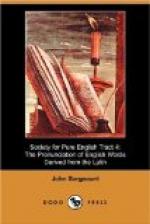Title: Society for Pure English Tract 4 The Pronunciation of English Words Derived from the Latin
Author: John Sargeaunt
Annotator: H. Bradley
Release Date: March 15, 2005 [EBook #15364]
Language: English
Character set encoding: ASCII
*** Start of this project gutenberg EBOOK society for pure English tract 4 ***
Produced by David Starner, William Flis, and the Online
Distributed Proofreading Team.
Transcriber’s Note: Phonetic
characters are represented by the
following symbols:
[`x] = any letter “x” with
grave accent
[’x] = any letter “x”
with acute accent
[:x] = any letter “x” with
superior double-dot (dieresis)
[^x] = any letter “x” with
superior circumflex
[=x] = any letter “x” with
superior macron
[)x] = any letter “x” with
superior breve
[e] = inverted “e” or schwa
[ae], [oe] = ae, oe ligature characters
[=xy] = any pair of letters “xy”
with joining macron, except
[=oe], [=ae] = oe, ae ligature
characters with macron and
[’oe], [’ae] = oe, ae ligature
characters with acute accent and
[)xy] = any pair of letters “xy”
with joining breve, except
[)ae], [)ae], [)oe], [)oe] =
ae, ae, oe, oe ligature characters
with
breve
[^1] = raised “1”, etc.
S.P.E. TRACT NO. IV
THE PRONUNCIATION OF ENGLISH WORDS DERIVED FROM THE LATIN
BY JOHN SARGEAUNT
WITH PREFACE AND NOTES BY H. BRADLEY
Correspondence & miscellaneous notes by H.B., R.B., W.H.F., And editorial
AT THE CLARENDON PRESS MDCCCCXX
ON THE PRONUNCIATION OF ENGLISH WORDS DERIVED FROM LATIN
[This paper may perhaps need a few words of introduction concerning the history of the pronunciation of Latin in England.
The Latin taught by Pope Gregory’s missionaries to their English converts at the beginning of the seventh century was a living language. Its pronunciation, in the mouths of educated people when they spoke carefully, was still practically what it had been in the first century, with the following important exceptions. 1. The consonantal u was sounded like the v of modern English, 2. The c before front vowels (e, i, o, [ae], [oe]), and the combinations t[)i], c[)i] before vowels, were pronounced ts. 3. The g before front vowels had a sound closely resembling that of the Latin consonantal i. 4. The s between vowels was pronounced




